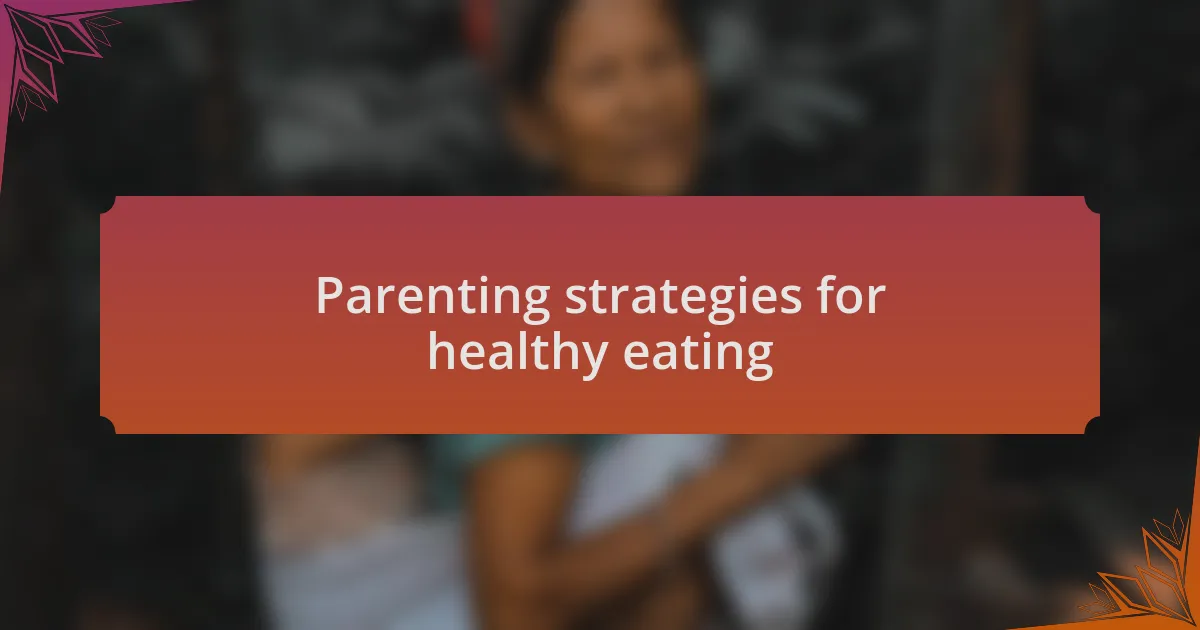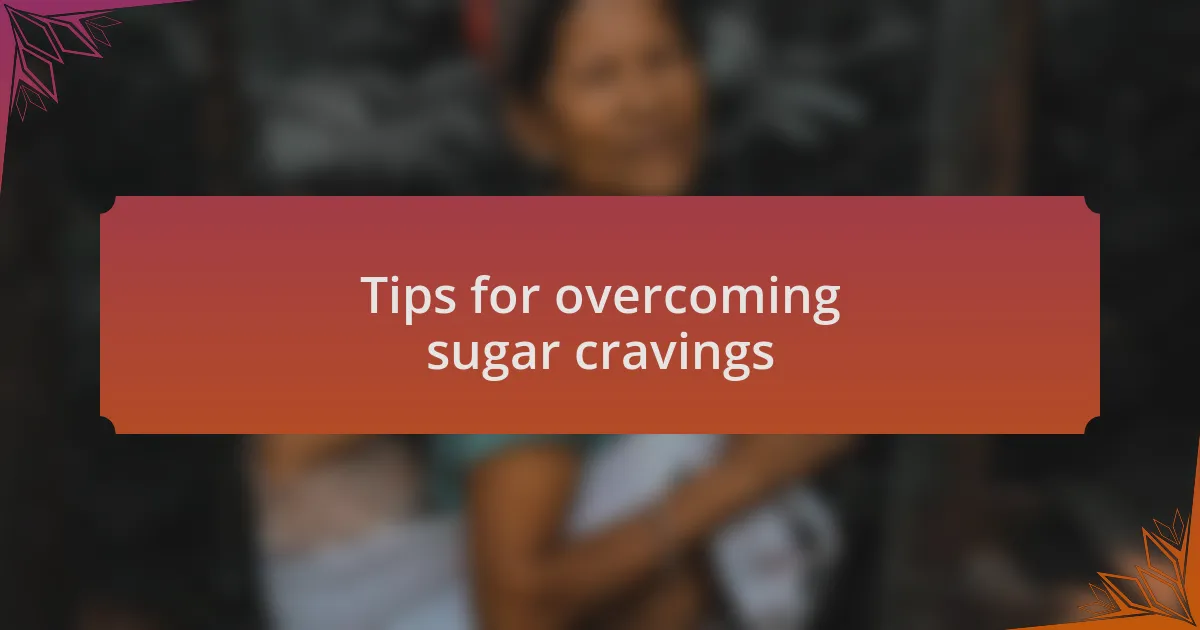Key takeaways:
- Sugar cravings can be influenced by emotional triggers and hormonal fluctuations, highlighting the importance of understanding the root causes.
- Involving children in meal preparation and fostering a positive mealtime atmosphere can encourage healthy eating habits and family bonding.
- Nutrition education should focus on the reasons behind food choices and can be enhanced through engaging discussions, such as grocery shopping challenges.
- Managing sugar cravings can be achieved by keeping healthy snacks available, staying hydrated, and finding alternative stress relief methods.

Understanding sugar cravings
Sugar cravings can often feel overwhelming, almost like a relentless whisper urging you to indulge. I remember vividly a Saturday morning when I found myself reaching for cookies before breakfast, thinking, “Why can’t I just wait until later?” It’s fascinating how our bodies react to sugar, creating a cycle that can feel impossible to break.
These cravings are not just about wanting something sweet; they can be tied to emotional triggers or the body’s need for quick energy. For instance, after a long day of parenting, I often found myself craving chocolate, as if it were a small reward for my hard work. Have you noticed how emotions can lead you to the pantry? This connection is part of understanding your relationship with sugar.
Interestingly, many factors contribute to sugar cravings, from hormonal fluctuations to the foods we commonly consume. I’ve experienced days where just a small amount of sugar seemed to lead to insatiable desires later on. Why does one bite open the floodgates? Recognizing these patterns helps in addressing the underlying causes rather than just combating the cravings themselves.

Parenting strategies for healthy eating
Adopting healthy eating habits in the family starts with leading by example. I recall a time when I swapped out sugary snacks for colorful fruits and veggies, and my kids surprisingly enjoyed them. It’s amazing how much children mirror the behaviors of their parents. Have you ever noticed how a simple change can inspire kids to rethink their choices?
Another effective strategy is involving your children in meal preparation. When my kids helped me cook, they seemed more excited to eat what they had made. It’s all about ownership; giving them a sense of accomplishment can turn healthy foods into an adventure rather than a chore. Have you tried letting your little ones pick their favorite healthy recipes?
Lastly, creating a positive mealtime atmosphere makes a significant difference. I remember a dinner where we turned off distractions, shared a story, and celebrated what we had prepared together. This not only fostered a love for healthy eating but also strengthened our family bonds. What if each meal became an opportunity for laughter and connection, transforming the way we view food?

Nutrition education for children
Nutrition education for children is more than just teaching them what to eat; it’s about helping them understand why these choices matter. I remember when my daughter asked why I chose whole grains over white bread. It opened a door to a conversation about energy levels and how certain foods can impact our mood. Have you ever considered how curious questions from kids can lead to valuable lessons in nutrition?
Involving kids in discussions about food labeling can also ignite their interest in nutrition. One day, my son noticed the different sugar contents in popular snacks at the grocery store. We turned it into a fun challenge to find snacks with less sugar. It was astounding to see him take pride in choosing healthier options. Have you thought about turning grocery shopping into a mini-lesson on nutrition?
Finally, it’s essential to incorporate stories around food and nutrition history. Sharing how generations before us grew their own vegetables or created family recipes can create a deeper appreciation for what they eat. I often share how my grandmother used to grow her own garden. This narrative not only fosters a connection to our family history but also instills respect for nutritious foods. What stories do you have that can inspire your children to embrace a healthier lifestyle?

Personal journey with sugar cravings
When I reflect on my journey with sugar cravings, I can’t help but remember a trying moment when I was sitting on the couch after a long day. I had a bowl of chocolate ice cream in hand, feeling that familiar tug of guilt as I indulged. It hit me that I often used sweets as a reward or a comfort, but I realized I needed to understand why I turned to sugar so often. Have you ever found yourself reaching for something sweet just out of habit?
As I began to educate myself about the effects of sugar on my body, I noticed that my cravings weren’t just physical; they were emotional too. Each time I faced stress, I would gravitate toward sugary snacks, believing they would elevate my mood. I remember a specific instance where I swapped my favorite candy for a piece of fruit, and surprisingly, that small change brought me a sense of satisfaction without the crash. Isn’t it fascinating how sometimes the simplest adjustments can have a significant impact?
Over time, I discovered that mindfulness played a crucial role in managing my cravings. I started journaling about my food choices and feelings, which helped illuminate patterns I previously overlooked. One particular entry captured my attention: it revealed how certain emotions were tightly linked to my desire for sweets. It made me wonder, what are we really craving when we reach for that donut? Sometimes, I think it’s not just about the sugar; it’s about finding a healthier way to nurture ourselves.

Tips for overcoming sugar cravings
When trying to overcome sugar cravings, I’ve found that keeping healthy snacks on hand is a game changer. It’s not just about saying no to sugar; it’s also about having delicious alternatives ready to go. The first time I reached for a handful of nuts instead of cookies, it was a small triumph, but it felt empowering. Have you thought about how easy it is to replace a sugary snack with something equally satisfying?
Another strategy that worked wonders for me was staying hydrated. I used to mistake thirst for hunger, and I often turned to sweets out of sheer dehydration. One day, I made it a point to drink a glass of water whenever I craved something sweet. The funny thing is, I found that simply waiting a few minutes often diffused the craving. Isn’t it amazing how a small shift in perspective can change how we listen to our bodies?
I’ve also learned the importance of managing stress in sugar cravings. During busy days filled with responsibilities, I used to crave sweets as a quick fix for my overwhelm. Instead, I started incorporating short relaxation breaks into my routine. I recall one afternoon when a brief walk outdoors helped me regain focus, steering me away from the pull of chocolate. In moments like these, I realized it’s crucial to find healthier outlets for stress. Have you considered what other activities might fulfill those emotional needs?